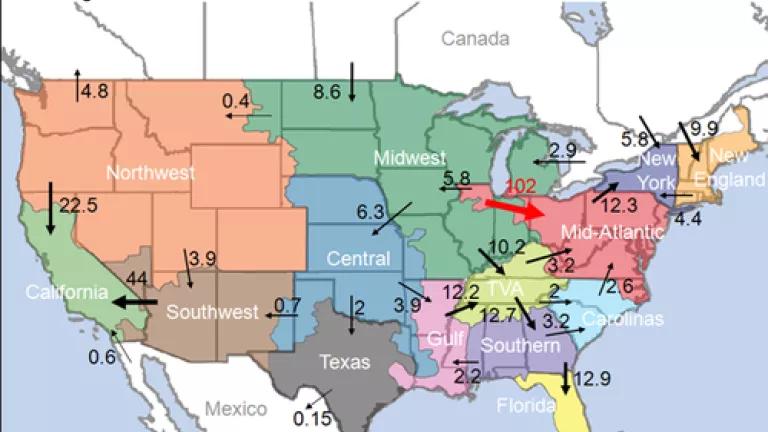
The Federal Energy Regulatory Commission (FERC) issued an important set of reforms intended to save consumers money and improve the transmission planning process more than two years ago, but the merits of “Order 1000” were still being debated yesterday in a Washington, D.C., federal courtroom.
Order 1000 includes several major changes: expanding regional and inter-regional transmission planning, accounting for clean energy and other public policies in that planning, fairly allocating the costs of new transmission lines among customers, and more competition for building those projects.
Grid planning regions have been complying with the rule for over two years. Nevertheless, some opponents of the rule, resistant to Order 1000’s reforms, challenged the rule in federal court. Yesterday the court heard oral argument in this case. I attended the three-hour event along with dozens of other industry and public interest attorneys in a filled courtroom. As I listened to the lawyers for FERC, utilities, and other challengers argue over Order 1000’s merits, I was reminded of why—even with its imperfections—Order 1000 is so important to achieving a cleaner, more sustainable energy future.
Here’s why:
Among Order 1000’s most important reforms is that it requires transmission-owning utilities in regions without electricity markets, like the Southeast and most of the West, to create and participate in regional planning processes, complete with more transparency and stakeholder participation. FERC’s basic idea, supported by evidence in the Order 1000 rulemaking record, is that regional grid planning will result in more cost-effective and efficient solutions than many different and uncoordinated local plans.
The notion of regional planning isn’t such a big deal in parts of the country like the Northeast, Mid-Atlantic, Midwest, and California, where regional transmission organizations like PJM and MISO started doing regional planning years ago. But in the Southeast, where Southern Company dominates, or in most of the West, each utility mostly stuck to local planning for how they will move electricity to their customers. They didn’t consider whether more regional transmission or non-transmission solutions (like energy efficiency or new renewables), coordinated with their neighboring utilities, could help meet the needs of their customers while saving those customers money.
Order 1000 includes another important reform especially critical for the Sustainable FERC Project and its partners: requiring local and regional grid planners to consider the impacts of federal, state, and local public policies on grid needs. State renewable energy, energy efficiency, and carbon pollution standards are examples, as is any other law or regulation likely to affect future grid needs. The Sustainable FERC Project and several of our colleagues in other organizations intervened in the Order 1000 litigation specifically to support FERC’s decision on this issue, and you can read our brief here.
The arguments
Back to the oral argument; the three judge panel of the U.S. Court of Appeals for the D.C. Circuit asked many questions about nearly all of the major issues in Order 1000. Some of the questions delved deeply into topics only a lawyer could love, like the meanings of the words “practice” in the Federal Power Act, or FERC’s acting on the basis of a “theoretical threat.” Arcane as these issues may sound, they have tremendous consequences for all users of the grid.
As I listened to the arguments, however, my mind sometimes drifted away from the courtroom to the outside world, where all of the transmission planning regions are already complying with Order 1000 and working on hard planning issues. The process isn’t perfect, and we’re not happy with all of the results to date because we’d like to see public policies take more center stage with reliability and economic issues (they’re all intertwined, after all), but we are seeing progress.
Order 1000 sensibly recognizes that we no longer live in our own small worlds, at least where the grid is concerned. Energy moves all around the country, as shown in this Energy Information Administration map of power flows:
If anything, we are moving to a more interregional grid, and eventually interregional planning and markets probably will be the rule rather than the exception.
Regional planning is better for clean energy and the environment
We already know that regional solutions are better in the specific context of the impending U.S. EPA carbon pollution standards for existing power plants, due out in June 2014. The nation’s regional grid operators (PJM, MISO, and others) recently issued a white paper on the upcoming carbon standards. Their paper argues that regional compliance solutions can be more efficient than requiring only local solutions. In the same vein, MISO, the grid operator for the Midwest and mid-South, just released a study showing that regional carbon standard compliance could save billions of dollars annually over more localized solutions.
Listening to some of the opponents of Order 1000 at yesterday’s oral argument, I couldn’t help but think that they want to turn the clock backward, to a world where local power was the only power, environmental and energy policies had no relevance to grid planning, and the incumbent utilities held most of the planning cards. Their focus on the local rather than the regional or interregional will in a very real sense fail to serve human health and the environment. Restated in FERC-speak, local planning alone will likely to lead to an inefficient and more costly grid, and unjust and unreasonable transmission rates for all customers.
(Note: You can listen to the recording of the 3-hour oral argument; we expect the court to issue a decision in the Order 1000 litigation later this year.)

